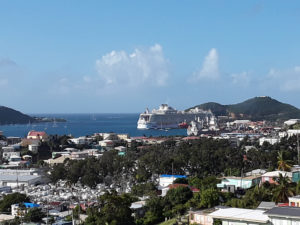
I had the pleasure of attending the Town Hall at Charlotte Amalie High School in late August. I would like to make a few belated comments on the proposals put forward by Governor Albert Bryan Jr. and his staff.
First, relative to discussions about the economy of downtown Charlotte Amalie, one of the many reasons there are so many closed businesses is because it is no longer a “freeport.” With gross receipts taxes, excise taxes — and the final nail in the coffin, sin taxes — one can buy anything aboard the cruise ships cheaper; even alcohol and tobacco are less expensive than on St. Thomas. Then there is the internet, where shopping is easier than taking a taxi into Charlotte Amalie to find no bargains. So, why should anyone shop in St Thomas?
When it was a freeport, anyone — tourists and locals alike — could buy name brands such as Louis Vuitton, Chanel and Christian Dior at 20% to 40% less than stateside. And landlords, who were accustomed to high rents for a high lifestyle, now find themselves in a different and difficult position to lower their rents.
As for parking downtown, a two-story parking lot was discussed by the Historic Preservation Commission when I was a commissioner of that board. It would be on the present parking lot next to Fort Christian, incorporating the historical buildings on Norre Gade — with the remaining facades simulating old buildings. It would include a tramline service to take persons from the car park, west along Norre Gade to Main Street then turn left on Strand Street at Market Square, to the Waterfront then back east to the parking lot, with stops along the route. This would be an added income to help maintain the car park and the tramline and the surrounding areas.
The idea of razing historic buildings for parking is a bad one. The Virgin Islands is most fortunate to have the three most beautiful historic towns in the Lesser Antilles. This heritage should be taught in schools together with art classes. As an aside, the most famous artist of the Impressionist Movement, Camille Pissarro, was born on St. Thomas. Described as the Father of Impressionism, he introduced fusing tropical colors and light after returning to France and making this movement a worldwide success.
The three “neo-classical” towns’ design roots go all the way back to the famed Egyptian Architect Imhotep (2600 BC), whose columns in the temples of Luxor and Karnak so impressed the Greek civilization that their Architect Callicbates (470 BC – 420 BC) were influenced to build their temples with columns surrounding them with gabled roofs. It also incorporated the famed Roman Architect “Marcos Vitruvius Pollio” (80 BC – 15 BC), and later the Byzantine Empire with Anthemius of Tralles, circa 474 AD.
After the fall of the Byzantine Empire to the Ottoman Turks, the Roman world rose again with the Renaissance in Italy during the 1300s AD. The most famous architect of this revival was Andrea Palladio, who revived the “Greek Revival Style” by adding a portico of columns and gable roofs to the existing Italian farmhouses, becoming most famous throughout the western world. He spread his designs to Sir Christopher Wren in England via his famous St. Paul’s Cathedral, influencing the Danish Architect Gustav Frederick Hetch (1788-1864).
There are a lot of examples of these (Greek Revival) Neoclassical forms throughout the Virgin Islands; a perfect example is the Reform Church in Charlotte Amalie, St Thomas. The influence is also visible in the lots of cluster columns at the corners at the front of the Grand Hotel. Further, albeit filled in, there are Egyptian columns and Roman arches on the side of the building housing “Hublot” on Commandant Gade (Garden Street).
With all this said, why aren’t these towns celebrated during Black History Month? After all, while these towns may have been designed by Danes they were built by Africans free and unfree. This built heritage needs to be put on the top of the list of celebrations, as it goes back to the very beginning of the settlement of all involved.
It should also be protected — laws enforced to protect them and an enforcement officer attached to the HPC so this heritage would be protected forever.
The idea of a conservator would only complicate the issue involving the neglected heritage of the district. The probate of wills should not take longer than one year, and the owner and owners of these properties should face confiscation by eminent domain if they cannot get together to restore and save their inherited heritage or sell them.
The V.I. government, together with the office of the Historic Preservation Commission should offer mortgages at one percent to all the properties in the control district (What do you mean here) downtown Charlotte Amalie?) and overseen by the federal state (What do you mean here?). We no longer have a town that attracts duty-free buyers unless the government returns it a freeport like the Danes did or makes it into a historic destination much like Savanna, Georgia or Charleston, South Carolina.
I can say a lot more as to why the town is in such a state, but I leave that for another time. I have had a business and lived in the downtown area since 1974 and saw the decline and all the reasons for it. I rest my pen.
Philip Sturm, St. Thomas


